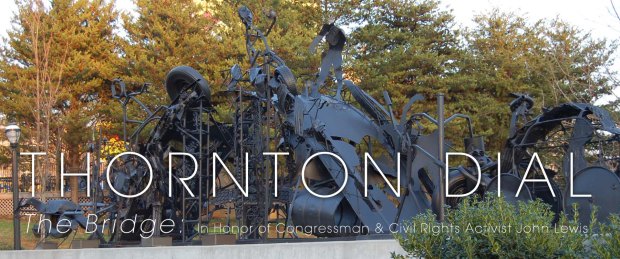Every February Americans celebrate Black History Month and collectively commemorate the trials and contributions of the black community. However, this month is not merely a celebration of African-American contributions; it is a time of recognition of the triumphant unification of people. Atlanta’s rich cultural history, specifically in relation to the Civil Rights movement, provides the world an insightful understanding of equality and diversity. This understanding has been enriched by writers, singers, dancers, actors, and visual artists who have paid homage to the victorious spirit of the American South.
Artistic Giant, Thornton Dial, is regarded as the most important artist to rise amid the tremendous social and political changes that transformed the Deep South and the world. More broadly, his tireless advocacy of society’s under-dogs gives voice to the historically disenfranchised, placing him among the greatest artists of all time. His work draws from a perspective of not only African-Americans, but the examination and exemplification of all working class Americans, much like the works of artists during the American Industrial Revolution and Regionalism. Dial’s contemporary approach challenges the boundaries of conceptual art and redefines painting and sculpture.
Thornton Dial rose to national prominence in the late 1980s due to his magnificently complex assemblages that narrate an unspoken story within our culture. Dial’s work serves as a chronicle of his insights into human relationships during a turbulent era in American history; one which spanned the decades of the Jim Crow South and extend into the socio-cultural, political, economic and spiritual struggles that characterize our time. Dial’s life has been defined by hard labor; this informs his assemblages that are constructed of organic and industrial materials, embedded with a kaleidoscopic array of found elements. His gestural and raw aesthetic draws inspiration from the landscape, both literal and metaphorical, and transforms its discarded media into an iconographic language that not only represents but reforms tradition.
Due to Dial’s acclaim as an artist, it comes as no surprise that Atlanta would select his work to commemorate the hard work and dedication of civil rights titan, Congressman John Lewis. Dial and Congressman Lewis are not only connected by their socio-political efforts to promote unity, but share a background of growing up in the Deep South, specifically in Alabama. Dial’s breathtaking sculpture, “The Bridge,” is located in the John Lewis Plaza on the corner of Freedom Parkway and Ponce de Leon. According to The Freedom Park Conservancy, “Each piece of the sculpture marks a poignant moment in the Congressman’s life from his rural past in Alabama; his civil rights journey that includes his courageous march across the Edmund Pettus Bridge in Selma, Alabama 40 years ago; his days as an Atlanta City Council member; to his current role as U.S. Representative for Georgia and a leading voice for human rights for all Americans.”
If you have not visited Freedom Park already, “The Bridge” is a truly noteworthy site to see. More of Thornton Dial’s work can be viewed at Bill Lowe Gallery. The gallery has a vast and unique collection of Dial’s earlier and most recent assembled mixed-media as well as a comprehensive collection of Dial drawings.


